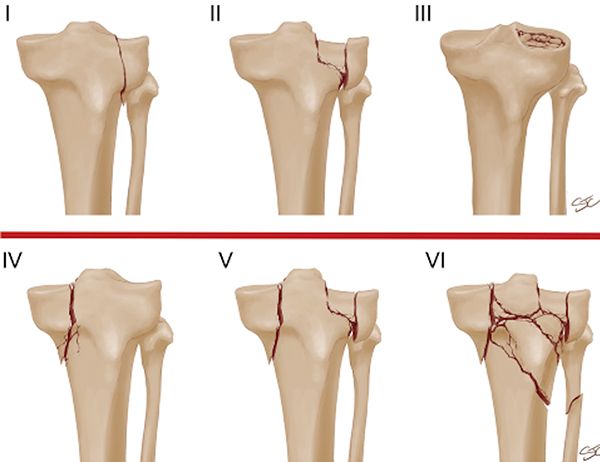Tibial Plateau Fracture
There are three bones that make up the knee joint – the femur (thigh bone), the tibia (shin bone), and the patella (kneecap). The tibial plateau is the flat, top surface of the tibia that forms the bottom part of the knee joint. The tibial plateau is an important weight-bearing area of the knee joint that plays a key role in the stability and overall function of the joint.
A tibial plateau fracture is a type of injury that involves the upper part of the tibia known as the plateau. When a force, often from high-energy impacts like falls, car accidents, or sports injuries, is applied to the knee, it can cause the tibial plateau to break. The fracture can vary in severity, ranging from hairline cracks to more complex breaks that may involve displacement of the bone. Injuries to the tibial plateau can affect the stability and function of the knee joint.

Tibial plateau fractures account for 1% of all fractures and are typically sustained with high-energy forces applied to the knee.
- Falls: Falling from a height or slipping and landing on the knee can transmit a significant force to the tibial plateau, leading to fractures.
- Sports Injuries: Participating in high-impact sports, such as skiing, football, or soccer, where there is a risk of falls or collisions, can increase the likelihood of tibial plateau fractures.
- Direct Blows to the Knee: Direct blows to the knee, such as those experienced in contact sports or car/motorcycle accidents, can cause fractures by exerting excessive force on the tibial plateau.
- Axial Loading: This occurs when a vertical force is applied to the leg, often in a situation where the foot is planted, and the body weight comes down onto the knee. This can happen in activities like jumping or landing from a height.
The symptoms of a tibial plateau fracture can vary depending on the severity of the injury, but common signs and symptoms include:
- Pain: Pain around the knee is a primary symptom. The intensity of the pain may vary, but it is typically aggravated by movement or putting weight on the affected leg.
- Swelling: Swelling around the knee joint is a common response to the injury. The extent of swelling may depend on the severity of the fracture.
- Bruising: Bruising (ecchymosis) may develop around the knee or lower leg due to blood leakage from damaged blood vessels.
- Limited Range of Motion: Individuals with a tibial plateau fracture often have trouble moving the knee and may have a reduced range of motion.
- Inability to Bear Weight: Many people with tibial plateau fractures find it challenging or impossible to bear weight on the affected leg due to pain and instability.
- Deformity: In more severe cases or when the fracture involves displacement of the bone, there may be visible deformity or changes in the alignment of the knee.
- Crepitus: Some individuals may experience a grating or crunching sensation (crepitus) when moving the knee, which can be indicative of bone fragments rubbing against each other.
The combination of a detailed history, comprehensive physical examination, x-rays, and possibly an MRI or CT scan is the key to a successful diagnosis of a tibial plateau fracture. Dr. Jorge Chahla and his team will complete a thorough exam to evaluate your range of motion, stability, and points of tenderness to palpation. X-rays will be obtained to allow Dr. Chahla to assess the integrity of the tibial plateau fracture and the extent of the injury. A CT scan may be ordered by Dr. Chahla to further evaluate the severity of the fracture, especially if it is likely that surgery will be required to fix the fracture. An MRI may be ordered to assess for possible associated meniscal, ligamentous, or cartilage injury.
A tibial plateau fracture is a break in the upper portion of the tibia (shinbone) near the knee joint. This type of fracture can occur due to high-impact trauma, falls, or sports injuries, leading to pain, swelling, difficulty bearing weight, and knee instability. Because the tibial plateau plays a crucial role in supporting body weight and allowing knee movement, prompt and proper treatment is essential to avoid long-term complications such as arthritis or joint instability. Dr. Jorge Chahla, a highly experienced orthopedic knee surgeon, specializes in diagnosing and treating tibial plateau fractures to ensure optimal healing and restore knee function. If you have sustained a knee fracture, schedule an appointment with Dr. Chahla in Chicago, Naperville, or Oak Brook for expert evaluation and care.
At a Glance
Dr. Jorge Chahla
- Triple fellowship-trained sports medicine surgeon
- Performs over 800 surgeries per year
- Associate professor of orthopedic surgery at Rush University
- Learn more

